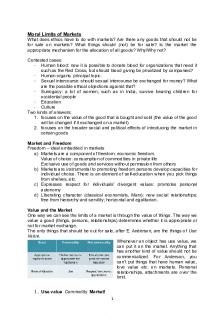Atterberg Limits report PDF

| Title | Atterberg Limits report |
|---|---|
| Author | Ryan Yere |
| Course | Soil Mechanics Technology Laboratory |
| Institution | California State University Long Beach |
| Pages | 5 |
| File Size | 93.7 KB |
| File Type | |
| Total Downloads | 98 |
| Total Views | 144 |
Summary
Lab report on Atterberg Limits for soil mechanics...
Description
Atterberg Limits
Prepared by
Ryan Yere Team #3
February 19, 2020
1
TABLE OF CONTENTS Section
Pages
1.0
INTRODUCTION…………………………………………………………. 2
2.0
THEORY DEVELOPMENT………………………………………………. 2
3.0
TEST EQUIPMENT & EXPERIMENTAL PROCEDURES……………... 3
4.0
PRESENTATION OF TEST RESULTS…………………………………... 4
5.0
SUMMARY AND CONCLUSION………………………………………... 4
APPENDICES Appendix A – Liquid Limit Test Appendix B – Plastic Limit Test
2
1.0
INTRODUCTION
This report summarizes the results of laboratory testing to determine the liquid limit and plastic limit of soil samples. Enclosed we have the theory of development of the experiment, using liquid limit testing/plastic limit testing with appropriate equipment and followed the procedures to obtain our data on Appendix A and B. We used equations to calculate our data. A summary section was used to present the major findings of this experiment.
2.0
THEORY DEVELOPMENT
The moister content of soil can be classified into four different states: solid, semisolid, plastic, and liquid. Each state represents a significant turning point in the soil’s behavior. These transition boundaries are represented as limits, as the soil moves from one state to the next. The limits are as follows: plastic to liquid is the liquid limit (LL), semi-solid to plastic is the plastic limit (PL), and lastly, solid to semi-solid is the shrinkage limit (SL). We use Atterberg Limits test to measure cohesive soil samples and the transition limits to classify the soil at different moister content. To find these limits we use Casagrande’s LL apparats to find the liquid limit, and Terzaghi’s 1/8” diameter criteria for plastic limit. We can us this understanding to correlate with other soil properties, such as plasticity index (PI), and compressive index (CI).
The equations used in this experiment are as follows:
3.0 TEST EQUIPMENT AND EXPERIMENTAL PROCEDURES
3
The following equipment were used: 1. 2. 3. 4. 5. 6.
Soil Cup Spatula Liquid limit (LL) test device Electronic scale Oven
Experimental procedures for LL test: 1. Put soil in cup 2. Add Water to soil, mix thoroughly with spatula 3. Clean and adjust LL test device 4. Butter soil into brass cup 5. Make groove 6. Count the number of blows to half inch groove - Successful test only # blows: (25-35), (20-25), (15-20) 7. Repeat steps 1-6 after each successful test 8. After a successful test, obtain a specimen to measure w% Experimental procedures for Plastic Limit test: 1. Obtain marble size of specimen 2. Find a clean space on bench and roll marble into 1/8” diameter thread 3. When 1/8” thread crumbles, obtain specimen for w% 4. Repeat steps 1-3
4
4.1
PRESENTATION OF TEST RESULTS
For the results of the liquid limit and plastic limit test we used the LL apparats and the 1/8” diameter test to collect the data shown in appendix A and B. We calculated the LL to be 48.5%, and our plasticity index to be 22.89%.
5.0
SUMMARY AND CONCLUSION
This report summarizes the results obtained from Atterberg Limits test. We measured the liquid limit to be 48.5% and averaged our Plastic Limit from two tests to be 22.89%. We also calculated the Plasticity Index, which is the difference between the Liquid Limit and the Plastic Limit, which equated to 25.6%....
Similar Free PDFs

Lab Report Atterberg Limits
- 8 Pages

Atterberg Limits report
- 5 Pages

Atterberg Limits Formula
- 3 Pages

BAB II Atterberg Limit
- 12 Pages

Limites DE Atterberg 1
- 10 Pages

Informe #3 - LIMITES DE ATTERBERG
- 18 Pages

Atterberg- Plastic Limit TEST
- 5 Pages

Labo. 2 Limites de Atterberg
- 18 Pages

Know Your Limits Assignment
- 2 Pages

103 worksheet limits
- 4 Pages

Moral Limits of Markets
- 4 Pages

14.2 Limits And Continuity
- 4 Pages

1-Limits Student Notes 2021
- 34 Pages
Popular Institutions
- Tinajero National High School - Annex
- Politeknik Caltex Riau
- Yokohama City University
- SGT University
- University of Al-Qadisiyah
- Divine Word College of Vigan
- Techniek College Rotterdam
- Universidade de Santiago
- Universiti Teknologi MARA Cawangan Johor Kampus Pasir Gudang
- Poltekkes Kemenkes Yogyakarta
- Baguio City National High School
- Colegio san marcos
- preparatoria uno
- Centro de Bachillerato Tecnológico Industrial y de Servicios No. 107
- Dalian Maritime University
- Quang Trung Secondary School
- Colegio Tecnológico en Informática
- Corporación Regional de Educación Superior
- Grupo CEDVA
- Dar Al Uloom University
- Centro de Estudios Preuniversitarios de la Universidad Nacional de Ingeniería
- 上智大学
- Aakash International School, Nuna Majara
- San Felipe Neri Catholic School
- Kang Chiao International School - New Taipei City
- Misamis Occidental National High School
- Institución Educativa Escuela Normal Juan Ladrilleros
- Kolehiyo ng Pantukan
- Batanes State College
- Instituto Continental
- Sekolah Menengah Kejuruan Kesehatan Kaltara (Tarakan)
- Colegio de La Inmaculada Concepcion - Cebu


